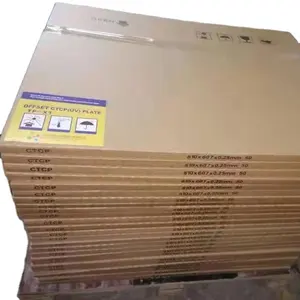
All categories
Featured selections
Trade Assurance
Buyer Central
Help Center
Get the app
Become a supplier

(1180 products available)







































ctcp printing plates play a crucial role in the printing industry, providing essential solutions for high-quality image reproduction and efficient printing processes. These are specialized components used in various printing technologies, such as offset, flexography, and gravure printing. Typically made from durable materials like aluminum, copper, or polyester, ctcp printing plates are designed to transfer images onto different substrates, ensuring precision and consistency in print quality. As the demand for customized and high-resolution prints increases, the technology behind ctcp printing plates continues to evolve, offering advancements in durability, resolution, and environmental sustainability.
The diversity of ctcp printing plates available caters to different printing requirements, each offering unique properties and benefits. Common types include offset plates, flexographic plates, and gravure plates. Offset plates are typically made from aluminum and are widely used for producing newspapers, magazines, and brochures due to their ability to deliver sharp and consistent images. Flexographic plates, often made from rubber or photopolymer, are ideal for packaging materials, labels, and corrugated boxes, owing to their flexibility and adaptability to various substrates. Gravure plates, usually crafted from copper, are known for their capability to produce high-quality images with fine detail, making them suitable for printing wallpapers and gift wraps. Each type of ctcp printing plates is engineered to meet specific printing demands, ensuring optimal performance and output quality.
ctcp printing plates serve multiple functions in the printing process, enabling the efficient transfer of ink to substrates with precision. They are designed to withstand the mechanical pressures of printing presses, ensuring durability and long-lasting performance. Features such as high resolution, quick ink transfer, and resistance to wear and tear enhance their usability and effectiveness. High-resolution capabilities allow for the reproduction of intricate designs and detailed images, while quick ink transfer ensures vibrant colors and sharp contrasts. The durability of ctcp printing plates minimizes the need for frequent replacements, reducing downtime and increasing productivity in printing operations. Additionally, advancements in plate technology have led to the development of eco-friendly options that minimize environmental impact.
The production of ctcp printing plates involves the use of various materials, each selected for its specific properties and suitability for different printing techniques. Aluminum is a popular choice for offset plates due to its lightweight nature and ability to hold fine details. Copper is often used for gravure plates because of its excellent conductivity and ability to produce high-quality prints. Photopolymer is commonly utilized in flexographic plates for its flexibility and capacity to adapt to various surfaces. Additionally, additives such as stabilizers and coatings are incorporated to enhance the performance and longevity of ctcp printing plates. These materials impact the plate's resolution, durability, and compatibility with different inks, allowing for tailored solutions to meet diverse printing needs. As sustainability becomes a priority, manufacturers are exploring biodegradable and recyclable materials to reduce environmental impact.
Effective use of ctcp printing plates involves understanding their specific applications and optimizing their benefits. For best results, select the appropriate type of plate based on the printing process and the substrate being used. Ensure proper calibration and alignment during installation to achieve precise image reproduction and ink transfer. Regular maintenance and cleaning are essential to preserve the quality and extend the life of ctcp printing plates. In commercial settings, consider the potential for customization and branding by utilizing plates that can accommodate intricate designs and logos. Proper storage and handling of printing plates are crucial to prevent damage and maintain their integrity. Educating users on the advantages of different types of plates and encouraging the adoption of sustainable practices can significantly enhance printing efficiency and environmental responsibility.
Selecting the appropriate ctcp printing plates is crucial for achieving optimal printing results. The choice depends on the printing technology being used, the type of substrate, and the desired print quality. For instance, offset printing often requires aluminum-based ctcp printing plates due to their ability to produce sharp and consistent images. Flexographic printing, on the other hand, benefits from photopolymer ctcp printing plates for their flexibility and adaptability to different surfaces. It's important to match the ctcp printing plates with the specific printing process to ensure efficient ink transfer and high-quality output.
Consideration should also be given to the durability and environmental impact of the ctcp printing plates. Plates made from sustainable materials or those that can be recycled or reused are becoming increasingly popular as the industry shifts towards eco-friendly practices. Understanding the lifespan and maintenance requirements of the ctcp printing plates can help in making an informed decision, ensuring that the printing operations remain cost-effective and environmentally responsible.
The primary factors include the type of printing technology, substrate material, desired print quality, and environmental considerations. Each type of ctcp printing plates offers unique advantages depending on these factors, making it essential to evaluate the specific needs of the printing task.
ctcp printing plates directly influence the sharpness, resolution, and color accuracy of the printed material. High-quality plates with precise image transfer capabilities can significantly enhance the overall appearance of the print, ensuring vibrant and accurate reproductions.
Yes, manufacturers are increasingly offering ctcp printing plates made from sustainable materials or designed for recyclability. These options help reduce the environmental footprint of printing operations and align with modern sustainability goals.
Regular cleaning and proper storage of ctcp printing plates are essential to maintain their performance and extend their lifespan. Ensuring that plates are free from debris and correctly aligned during use can prevent premature wear and ensure consistent print quality.
Some ctcp printing plates can be reused depending on the material and printing process. Reuse is more common with durable plates designed for long print runs, but it requires careful handling and maintenance to ensure they remain effective for subsequent uses.